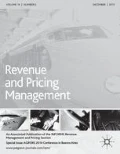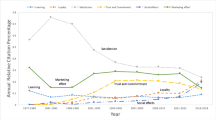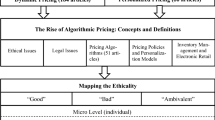Abstract
In this article, we consider the revenue management problem of firms with customers who use historical pricing data to make their purchasing decision. This behavior is modeled using the concept of reference price, which quantifies customers’ perceived ‘fair value’ of a product. We consider a segmented market consisting of two types of customers. One segment uses all price history to form a reference point and the other only uses the current price to do so. We study the revenue maximization problem of a firm who offers a two-price scheme in this market and derive closed form analytical solutions. Finally, we extend the monopoly model to a duopoly setting, and provide a numerical analysis on the added value of offering a two-price scheme compared to a single-price scheme and suggest a novel interpretation of such segmentation regime.









Similar content being viewed by others
References
Asvanunt, A. and Kachani, S. (2009) Multi-product Pricing with Reference Effects in Monopoly and Duopoly Markets. Working Paper.
Bertsekas, D.P. (2001) Dynamic Programming and Optimal Control, Vol. 2, 2nd edn. Nashua, NH: Athena Scientific.
Briesch, R.A., Krishnamurthi, L., Mazumdar, T. and Raj, S.P. (1997) A comparative analysis of reference price models. The Journal of Consumer Research 24 (2): 202–214.
Desai, P.S. and Purohit, D. (2004) ‘Let me talk to my manager’: Haggling in a competitive environment. Marketing Science 23 (2): 219–233.
Elmaghraby, W. and Keskinocak, P. (2003) Dynamic pricing in the presence of inventory considerations: Research overview, current practices, and future directions. Management Science 49 (10): 1287–1309.
Fibich, G., Gavious, A. and Lowengart, O. (2003) Explicit solutions of optimization models and differential games with nonsmooth (asymmetric) reference-price effects. Operations Research 51 (5): 721–734.
Gilbert, G.T. (1991) Positive definite matrices and Sylvester's criterion. The American Mathematical Monthly 98 (1): 44–46.
Greenleaf, E.A. (1995) The impact of reference price effects on the profitability of price promotions. Marketing Science 14 (1): 82–104.
Hardie, B.G.S., Johnson, E.J. and Fader, P.S. (1993) Modeling loss aversion and reference dependence effects on brand choice. Marketing Science 12 (4): 378–394.
Helson, H. (1964) Adaptation – Level Theory, 1st edn. New York, NY: Harper & Row.
Juo, C.-W., Ahn, H.-S. and Aydin, G. (2009) Dynamic Pricing of Limited Inventories when Customers Negotiate. Working Paper.
Kahneman, D. and Tversky, A. (1979) Prospect theory: An analysis of decision under risk. Econometrica 47 (2): 263–291.
Kalwani, M.U., Yim, C.K., Rinne, H.J. and Sugita, Y. (1990) A price expectations model of customer brand choice. Journal of Marketing Research 27 (3): 251–262.
Kopalle, P.K., Rao, A.G. and Assunção, J.L. (1996) Asymmetric reference price effects and dynamic pricing policies. Marketing Science 15 (1): 60–85.
Kopalle, P.K. and Winer, R.S. (1996) A dynamic model of reference price and expected quality. Marketing Letters 7 (1): 41–52.
Krishnamurthi, L., Mazumdar, T. and Raj, S.P. (1992) Asymmetric response to price in consumer brand choice and purchase quantity decisions. The Journal of Consumer Research 19 (3): 387–400.
Muthoo, A. (1999) Bargaining Theory with Applications, 1st edn. Cambridge, UK: Cambridge University Press.
Nerlove, M. (1958) Adaptive expectations and cobweb phenomena. The Quarterly Journal of Economics 72 (2): 227–240.
Popescu, I. and Wu, Y. (2007) Dynamic pricing strategies with reference effects. Operations Research 55 (3): 413–429.
Putler, D.S. (1992) Incorporating reference price effects into a theory of consumer choice. Marketing Science 11 (3): 287–309.
Rajendran, K.N. and Tellis, G.J. (1994) Contextual and temporal components of reference price. The Journal of Marketing 58 (1): 22–34.
Riley, J. and Zeckhauser, R. (1983) Optimal selling strategies: When to haggle, when to hold firm. The Quarterly Journal of Economics 98 (2): 267–289.
Samuelson, W. and Zeckhauser, R. (1988) Status quo bias in decision making. Journal of Risk & Uncertainty 1 (1): 7–59.
Stokey, N.L., Lucas, J.R.E. and Prescott, E.C. (1989) Recursive Methods in Economics Dynamics, 1st edn. Cambridge, MA: Harvard University Press.
Tversky, A. and Kahneman, D. (1991) Loss aversion in riskless choice: A reference-dependent model. The Quarterly Journal of Economics 106 (4): 1039–1061.
Urbany, J.E. and Dickson, P.R. (1991) Consumer normal price estimation: Market versus personal standards. The Journal of Consumer Research 18 (1): 45–51.
Wang, R. (1995) Bargaining versus posted-price selling. European Economic Review 39 (9): 1747–1764.
Winer, R.S. (1985) A price vector model of demand for consumer durables: Preliminary developments. Marketing Science 4 (1): 74–90.
Winer, R.S. (1986) A reference price model of brand choice for frequently purchased products. The Journal of Consumer Research 13 (2): 250–256.
Author information
Authors and Affiliations
Appendix
Appendix
Proof of Proposition 1
The Hessian matrix of the one-stage profit function given in equation (2) is as follows:

The first principal minor of this matrix is negative (−2(b1+c1)⩽0), and the second principal minor (4(b1+c1)(b2+c2)−c22⩾0) is positive by the regularity assumption. Hence by Sylvester criterion, Gilbert (1991), the Hessian is semi-negative definite and the objective function is jointly concave. The result follows from the first-order conditions. □
Proof of Corollary 1
Each firm will be using a linear function in the form of p1*(r)=mr+h to maximize her one-stage profit. The result follows from the observations that both m and h coefficients are increasing (decreasing) in reference price (absolute price) sensitivity, that is, c2(b2). □
Proof of Theorem 1
Results used in proof of Theorem 1 are as follows:
Proposition 10:
-
The optimal value function J*(r) is unique.
This follows from Stokey et al (1989) and Bertsekas (2001, p. 11, proposition 1.2.2) from the observation that (a) the state-space set is a convex subset of ℝ1, (b) the state update function f(r, p1) is non-empty, compact valued and continuous, and (c) one stage revenue function, π, is bounded and continuous and 0<β<1.
Proposition 11:
-
The optimal value function J*(r) is increasing in r.
This follows from the observation that the one stage profit π t (r t , p1, t, p2, t) and the next stage reference price r t =αr t +(1−α)p1, t are increasing in r t . Assume that a firm is implementing the (p 1 , p 2 ) policy with the initial reference price r (this policy is not necessarily stationary). Assume r′⩾r to be the new initial reference price. In the first period, implementing the same (p 1 , p 2 ) policy will yield a higher profit π0(r′, p01, p02)⩾π0(r, p01, p02) also we will have r1′⩾r1. As the optimal solution is bounded (follows from the linear form of the demand function), an inductive argument proves the proposition.
Given the above propositions we now proceed to prove Theorem 1. We postulate that the value function is of the quadratic form presented in equation (4). Hence the Bellman equation (3) becomes

The above maximization problem is concave and the optimal prices (p1*(r), p2*(r)) can be derived by first-order conditions. Solving the system of equations ∂J/∂p1=∂J/∂p2=0 for (p1, p2) yields the optimal policies (4) and (5). Substituting these optimal policies in (A1) and collecting the coefficients of the quadratic polynomial, we derive the values of coefficients γ, δ and ω. Now we just have to validate the sign of coefficients.
Choice of γ: γ is one of the roots of the following quadratic equation,

As the value function J*(r) is unique (Proposition 10) and increasing in r for all values of r>0 (Proposition 11) the coefficients γ, δ and ω should be non-negative real numbers. Assume that equation (A2) has real roots, as the coefficient of γ2 and γ0 are both positive, then the roots have the same sign. Hence for γ to be positive we require the coefficient of γ to be negative, which means:

The above inequality holds for the ‘regular’ problems. In such setting we have:

where the first inequality follows from minimizing the left side over all feasible value of β (for 0<α<1) and the second inequality follows from 0<α<1 and c2⩽b1 and the third inequity follows from b2 and c2⩾0. Hence, assuming the real roots exist they are both positive. Now we need to show that real roots exist. In order to show that, we need to show that the discriminant of equation (A2) is always positive. In order to do so, we first establish some preliminary results.
Recall

Lemma 1:
-
Monotonicity properties of Γ 2 :
1. Γ 2 is increasing in b2

We show that

and obviously for 0<α, β<1, max Ψ2=3. Hence,

where the last inequality follows from b2⩾0 and the regularity condition.
2. Γ 2 is decreasing in c2, when b2=0

Now we show that the discriminant of equation (A2) is always positive, that is,

The above inequality holds for the discriminant of equation (A2) of regular problems. In such settings we have:

where the first inequality follows from the increasing property of Γ2 in b2 and the second inequality follows from the decreasing property of Γ2 in c2. Now,

The above inequalities follow from 0<α, β<1. Hence, the real roots always exist for ‘regular’ problems. This derivation gives us two choices for γ. We choose γ as the smaller root of the equation (A2). We will show that this choice will lead to positive values for δ and ω.
Positivity of δ: In order to show that δ, equation (6), is well defined and positive we require that


In order to prove the above inequality we maximize the left-hand side:

The first inequality follows from maximizing the LHS over b2 and the second follows from maximizing over c2. The last step holds as the left-hand side of the last inequality is negative.
Positivity of ω: First we show that if the denominator of ω is positive then the enumerator is also positive. This follows from comparing the first two terms in Ω1 with the denominator. a2(b1+c1)−βγa2(1−α)2⩾a2[(b1+c1)−βγ(1−α)2−Ω2]⩾0. It only remains to show that the denominator is always positive. Hence, ω will be defined if and only if

We maximize the LHS of the above inequality.

The first inequality follows from maximizing the LHS as used in the previous steps and the last inequality follows as the left-hand side of the last inequality is negative.
Given the uniqueness result proved in Proposition 10 we have derived the optimal solution. □
Proof of Proposition 2
-
a
The proof follows from the condition for f*(r)⩽r.

Hence, if r⩽r** then f*(r)⩾r(†). This shows that if the initial reference price is lower than the steady-state reference price, the series of reference prices associated with the optimal path are increasing until they hit the reference price level or go higher. Next, we show that the series never goes above the steady-state reference price. This follows from the condition:

Hence, if r⩽r** then f*(r)⩽r**(‡). The monotone convergence result follows from (†) and (‡).
-
b
From the reference price update equation (1), we know that the steady-state price p1** is equal to r**. From equation (4), we know that the optimal price p1*(t) is increasing in r(t). Hence p1*(t) is an increasing series and the result follows for monotone convergence of p1*(t) series from part a. From equation (5) we know that p2* is an increasing function of p1*, hence the result for p2*(t) series follows directly. □
Proof of Corollary 2
-
a1. The increasing (decreasing) property of the optimal reference prices follows directly from the monotone convergence result in Proposition 2.
-
a2. Convexity (Concavity): from equation (6) we know that the progression of the optimal reference prices is characterized by the following series:

where A and B are coefficients characterized in equation (6). Hence

We show that 0⩽A⩽1.


the second line follows from positivity of r** and equation (6). It is easy to see that the enumerator of A is positive by maximizing Δ2. Hence, we only need to show the denominator is positive to establish positivity of A.

From the increasing (decreasing) property (part a) and observation that 0⩽A⩽1 we know:

The above inequalities coupled with 0⩽A⩽1 show that rt+1−r t , equation (A4), is decreasing in t and establish the convexity(concavity) property.
-
b1. The increasing (decreasing) property of the optimal first- and second-stage prices follows directly from the monotone convergence result in Proposition 2.
-
b2. p1, t* is a linear function of the reference price in the form p1, t*=Cr+D, where C is positive. This positivity is established in the same manner as part a of this corollary. In addition, p2, t* is also a linear function of the first-stage price with positive coefficients. The desired result directly follows as concavity (convexity) is preserved under such transformations. □
Proof of Proposition 3
The proof is same as Proposition 2 and follows from p1*(r)⩾r⇔r⩾r** □
Proof of Theorem 2
In this subsection, we derive the closed-form solution to the optimal pricing policy of a firm operating in the generalized setting discussed in the section ‘Generalized reference price update equation’. Recall J*(r0) is the optimal value of the optimization problem of the retailer that is derived from:

We retain all the assumptions of the subsection ‘Analysis: multi-period model’, hence as before the optimal value function J*(r) is the solution to the following Bellman equation:

Below we state Theorem 2 again fully without any reference to Theorem 1.
Theorem 2:
-
The optimal pricing policy for a retailer in the above general setting is


where

Proof: Propositions 10 and 11 hold same as the case of Theorem 1. We postulate that the value function is of the quadratic form presented in equation (4). Hence the Bellman equation (A1) becomes

The optimal prices (p1*(r), p2*(r)) can be derived by first-order conditions. Solving the system of equations ∂J/∂p1=∂J/∂p2=0 for (p1, p2) yields the optimal policies (A5) and (A6). Substituting these optimal policies in (A7) and collecting the coefficients of the quadratic polynomial, we derive the values of coefficients γ, δ and ω. Now we just have to validate the sign of coefficients.
Choice of γ: γ is one of the roots of the following quadratic equation,

The proof for positivity of γ is same as Theorem 1 and is omitted here.
Positivity of δ: The same proof as Theorem 1 goes through. We only need to show that the extra term added in enumerator is always positive.

Positivity of ω: The same proof as Theorem 1 goes through. We only need to show that the extra term added in enumerator is always positive.

In both the above arguments, the first inequalities are trivial and the second inequalities follow from the regularity condition.
Proof of Proposition 4
-
a
The proof is similar to the proof of Proposition 2 and its details are omitted here. The proof technique is the same and follows from the following observations

and

-
b
From the reference price update equation (7), we know that the steady-state price p1** is equal to ((1−k2)r**−k3)/k1. From equation (A5), we know that the optimal price p1*(t) is increasing in r(t). Hence, p1*(t) is an increasing series and the result follows for monotone convergence of p1*(t) series from part a. From equation (A6) we know that p2* is an increasing function of p1*, and hence the result for p2*(t) series follows directly. □
Proof of Proposition 5
This proposition is a special case of Theorem 2. This follows from the following observation:

Hence, set

and the results follow. □
Proof of Proposition 6
This proposition is a special case of Theorem 2. This follows from the following observation:

Hence, set

and the results follow. □
Proof of Proposition 7
This proposition is a special case of Theorem 2. This follows from the following observation. The myopic optimal decision of firm 2 is as follows (subscript t has been dropped):

Hence

Set

and the results follow. □
Proof of Proposition 9
If firm 1 uses a linear function of the reference price to choose her pricing decision, firm 2 observes a linear update function in terms of her own price and the reference price. Hence by Theorem 2 the optimal decision of firm 2 will be a linear function of the reference price. As a result of this, firm 1 will also observe a linear update function of the reference price and her own price and will keep her pricing function a linear function of the reference price. □
Rights and permissions
About this article
Cite this article
Huh, W., Kachani, S. & Sadighian, A. A two-stage multi-period negotiation model with reference price effect. J Revenue Pricing Manag 9, 443–475 (2010). https://doi.org/10.1057/rpm.2010.28
Received:
Revised:
Published:
Issue Date:
DOI: https://doi.org/10.1057/rpm.2010.28
















